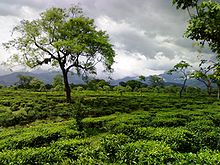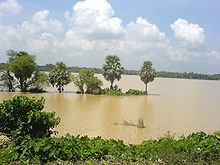Geography of West Bengal

The Geography of
Location and extent

West Bengal is on the eastern neck of India, stretching from the
Political geography
There are 23 districts and 5 divisions in West Bengal. The
Each district is governed by a
The capital of the state is Kolkata – the
Landforms
Darjeeling Himalayan hill region
Darjeeling Himalayan hill region is situated to the north of the state. This region belongs to the
The western mountains

The western mountains are the higher part of Darjeeling Himalayan range, with an average height of 2,200 m (7,200 ft). They spread from Nepal border to the Teesta river, and primarily consist of two mountain ranges: the Singalila Range and the Darjeeling range. The
(world's 5th highest peak) can be seen from the Singalila Range.The Darjeeling range rises steadily from Terai area. Located within this range, Ghum railway station (2,258 m) is the highest rail station in India. The famous Tiger Hill (2,567 m) is situated at the middle of this mountain chain and is a viewpoint from which some of the world's tallest peaks can be seen, including Kanchenjunga, Everest, Lhotse, and Makalu. Three minor mountain chains start from Tiger Hill: Darjeeling Lebong in the north, Takdah Peshok in the northeast, and Bagora Dowhill in the south. Sinchal (2,615 m) is one of the well-known peaks here.
The eastern mountains
The eastern side of the Darjeeling Himalayan mountains are lower than the western side, with an average altitude of 1,900 m (6,200 ft). Durpin Dara and Chola are two major mountain chains of this part.
The Durpin Dara chain holds the highest peak of eastern part: Rishila, at 3,121 metres (10,240 ft). There are two peaks, Renigango (1,885 m) and Chhoto Sinchula (1726m) to the north of Jalpaiguri district. The Buxa hill is located at the east end of this region. Sangchuli is the highest peak of the Buxa hills. Kalimpong town is one of the well-known towns of this area.
The Darjeeling Himalayan Railway (simply known as "toy train") has been listed in UNESCO world heritage sites.[6]
Terai region

The Teesta River divides the area into two parts: the Terai to the west and the Dooars (or Duars) to the east. The Dooars region can be further subdivided into the Siliguri (Western) Dooars, the Jalpaiguri (Middle) Dooars, and the Alipur (Eastern) Dooars.
The Terai ("moist land") is a belt of marshy grasslands, savannas, and forests at the base of the Himalaya range stretching southwards about 38 km. Above the Terai belt lies the Bhabar, a forested belt of rock, gravel, and soil eroded from the Himalayas. The Terai zone is composed of alternate layers of clay and sand, with a high water table that creates many springs and wetlands. The Terai zone is inundated yearly by the monsoon-swollen rivers of the Himalayas. The Terai–Duar savanna and grasslands is an ecoregion that stretches across the middle of the Terai belt, consisting of tall grasslands, savannas, evergreen forests, and deciduous forests [.
The Terai and
North Bengal plains
The North Bengal plains start from the south of Terai region and continue up to the left bank of the
The Mahananda River divides the district of Malda into two parts. The eastern part (known as Barind or Barendrabhumi) consists of undulating plains and tilas, and is made up of old alluvium and is part of the Ganges Delta. In contrast, the western part is made up of new alluvium, and here the Kalindi River joins the Mahananda River. The area north of the Kalindi River is a lowland covered with swamps and beels (small water bodies) and is known as tal. In contrast, the area south of the Kalindi is a very fertile land and is known as diara.
The plain south of
[1].Rarh region
Rarh is the region that intervenes between the
Coastal plain

A small coastal region is on the extreme south of the state. A part of the district of
Western plateau and high lands
The average altitude in the area ranges from 100 to 500 m. The area has a slope from the west to the east.
There are some badlands in this region. The Sinhati Badlands are located 4 km northwest of Bishnupur town in the Sinhati area of Bankura district.[7] The Gangani (or Garbheta) Badlands are located in Paschim Midinipur district beside river Shilabati. These badlands are also known as Grand Canyon of West Bengal.[8]
Ganges delta

The Ganges Delta covers the entirety of
The old delta consists of the districts of Murshidabad and Nadia. The formation of delta is complete and the rivers here are heavily silted and many have even dried up over time. Silted rivers, swamps, beels, and oxbow lakes form the area. This area is also known as Bagri region.
The districts of Kolkata and North 24 Parganas form mature delta region. The rivers are slow and meandering and frequently shift their courses. Swamps, beels, and oxbow lakes characterise the scenery. The district of South 24 Parganas is known to be the active delta of the Ganges, where the formation of the delta is still an ongoing process.
Agro-climatic groups

Depending on soil and climate variations, West Bengal can be divided into six broad divisions:[9]
- The hill region in the north
- The Terai and Teesta alluvial region of North Bengal
- The laterectic, red and gravely undulating region in the west
- The coastal alluvial region in the south
- The Gangetic alluvial region in the east
- The Vindhya alluvial region in the centre
Rivers

The
Numerous rivers flow eastwards through West Bengal and join the Bhagirathi on the right bank.[10] These include:
- The Mayurakshi River—which is fed by the Brahmani, Dwarka, Bakreshwar, and Kopai—joins the Bhagirathi near Kandi, Murshidabad.
- The Ajay River, which rises in the hills of Bihar and is joined by the Kunur, flows down the plateau fringe, marking the boundary between Bardhaman and Birbhum districts and joining the Bhagirathi near Katwa.
- The Damodar Valley Project.
- The East Midnapur district.
- The Orissa[1].
Similarly, several rivers flow westwards into West Bengal and join the Bhagirathi on its left bank.[10] These include:
- The Bhairab River and the Jalangi River, which join together (then known as Jalangi) before joining the Bhagirathi.
- The Churni and Ichhamati. The Churni meets the Bhagirathi, while the Ichhamati flows southwards and joins the Kalindi River.[10]
These rivers carry with them plenty of water, keeping the Bhagirathi River submerged with water throughout the year. The rivers also carry silt and sand eroded from the western plateaus and deposit them in the Bhagirathi. This silting causes trouble for the
The
The Teesta River cuts deep gorges from north to south in the mountainous Darjeeling district. It then enters the plains at Sevoke and flows in a mighty stream in a straight line towards the southeast, until it pours into the Brahmaputra River in Bangladesh.[10]
The
Wetlands

The Sundarbans delta is the largest
The average elevation of the area is 10 m. This area has been created by the deposition of silt from its numerous rivers—the
The area is known for its wide range of fauna. The most famous among these is the
Climate


West Bengal's climate varies from
In early summer, brief squalls and thunderstorms known as kal-baisakhi often arrive from the north or northwest.[12] Monsoons bring rain to the whole state from June to September. West Bengal receives the Bay of Bengal branch of the Indian Ocean monsoon that moves in a northwest direction. Winter (December–January) is mild over the plains with average daily low temperatures of 15 °C (59 °F).[11] A cold and dry northern wind blows in the winter, substantially lowering the humidity level. However, the Darjeeling Himalayan Hill region experiences a harsh winter, with occasional snowfall at places.
Natural resources

West Bengal stands third in India in terms of mineral production by state, contributing about one-fifth of the total mineral production of the country.[10]
There are possible deposits of mineral oil and natural gas in the areas near the
Research is ongoing in various places to locate natural gas.References
- ^ a b "Groundwater Arsenic Contamination Status in West Bengal". Groundwater Arsenic Contamination in West Bengal – India (17 Years Study). School of Environmental Studies, Jadavpur University. Retrieved 29 October 2006.
- ^ "Statistical Facts about India". indianmirror.com. Retrieved 26 October 2006.
- ^ a b "Urban agglomerations/cities having population 1 million and above" (PDF). Provisional population totals, census of India 2011. The Registrar General & Census Commissioner, India. 2011. Retrieved 26 January 2012.
- ^ a b "Cities having population 1 lakh and above, census 2011" (PDF). Provisional population totals, census of India 2011. The Registrar General & Census Commissioner, India. Retrieved 18 October 2011.
- ^ "Attractions of Sandakphu". Retrieved 8 March 2021.
- ^ "Darjeeling Himalayan Railway". Retrieved 8 March 2021.
- ISBN 978-3-319-26443-1, retrieved 26 February 2022
- S2CID 233918897.
- ISBN 81-7955-030-3. Archived from the original(PDF) on 27 May 2006. Retrieved 26 August 2006.
- ^ a b c d e f g h i j k l m n o p q r s t u v w Bhattacharya, Sudhansu Sekhar; Gupta, Sushmita (1977). Higher Secondary Economic Geography. Kolkata: Indian Progressive Publishing. pp. 316–359.
- ^ a b "Climate". West Bengal: Land. Suni System (P) Ltd. Retrieved 5 September 2006.
- ^ "kal Baisakhi". Glossary of Meteorology. American Meteorological Society. Archived from the original on 30 August 2006. Retrieved 5 September 2006.
1. Gautam Kumar Das. 2024. River Systems of West Bengal: Water Quality and Environment. In: River Systems of West Bengal. Springer Water. Springer, Cham. 180p. https://doi.org/10.1007/978-3-031-53480-5-1. https://link.springer.com/book/10.1007/978-3-031-53480-5.
2. Gautam Kumar Das. 2023. Coastal Environments of India, A Coastal West Bengal Perspective, Springer, Switzerland, ISBN: 978-3-031-18845-9, 232p. https://doi.org/10.1007/978-3-031-18846-6. https://link.springer.com/book/10.1007/978-3-031-18846-6.
3. Gautam Kumar Das. 2015. Estuarine Morphodynamics of the Sunderbans, Springer, Switzerland, 211p. https://doi.org/10.1007/978-3-319-11343-2. https://link.springer.com/book/10.1007/978-3-319-11343-2.
4. Gautam Kumar Das.2017. Tidal Sedimentation in the Sunderban’s Thakuran Basin, Springer, Switzerland, 151p. https://doi.org/10.1007/978-3-319-44191-7. https://link.springer.com/book/10.1007/978-3-319-44191-7.
5. Gautam Kumar Das. 2021. Forests and Forestry of West Bengal – Survey and Analysis, Springer, 231p, http://www.springer.com/ISBN 978-3-030-80705-4, https://doi.org/10.1007/978-3-030-80706-1.
